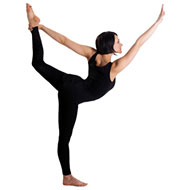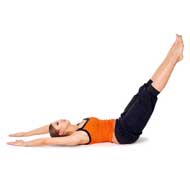- Mountain Pose
- Five pointed star pose
- Goddess Pose
- Cresent Moon Pose
- Chair pose
- Warrior I Pose
- Warrior II Pose
- Side Angle Pose
- Triangle Pose
- High Lunge
- Revolved Side Angle Pose - Parivrtta Parsvakonasana
- Wide-Legged Forward Bend - Prasarita Padottanasana
- Garland Pose
- Standing Split
- Revolved Triangle Pose
- Extended Triangle Pose
- Low Lunge
- Upward Forward Fold
- Big Toe Pose
- Extended Side Angle Pose
- Dolphin Pose
- Standing Forward Bend
Lord of the Dance Pose (Natarajasana)
The Natarajasana or the Lord of the Dance Pose has been inspired by the Hindu god Shiva. Shiva, also known as Nataraj, is also considered the lord of dance.
He dances an energetic dance. The natarajasana pose needs to be done gracefully, almost like a dance, in order to derive maximum benefit from it.
Steps :
- Stand in the tree pose or the tadasana. As you inhale, shift your weight to the left foot and lift your right heel towards your buttock. Put additional pressure on the straight left leg, thigh, hip and knee to ensure your legs are properly balanced.
- Now reach your right hand behind the raised leg and grasp the right ankle. Lift your hip and pubic area accordingly to avoid additional strain.
- With the help of your right hand, pull your right leg further up and extend your left hand in front of you.
- Stay in this pose 20-30 seconds and slowly come back to your starting position.
- Now, repeat this with the other leg.
Precautions :
If you suffer from low blood pressure then Lord of the Dance Pose is something you should not try and perform. You need to immediately stop doing the pose if you feel dizzy.
Beginner’s Tip :
- One important tip for beginners while doing this pose is to keep the lifted ankle flexible. Keeping the ankle flexible prevents cramps in the thigh muscles. Cramping muscles are a common complaint the beginners have.
Benefit To Body Part :
- This pose can stretch the thighs, the groin and the abdomen.
- The lord of the dance pose also stretches the shoulders, chest and legs, and moves all the way to the ankles.
- It improves posture and balance.
- The pose also strengthens legs and ankles.
Therapeutic Applications :
- This pose is used to improve concentration.
- It helps to center mind and body.
Variations :
- A variation for the lord of the dance pose includes using both hands to catch the foot that has been extended into the air. One hand catches the inner end of foot while the other hand clasps the outer end. This variation further improves the balance.
- You can also vary the pose by using a wall to support you while doing the pose the first few times. This variation is especially helpful to beginners.
- You can also use a partner while doing the pose to ensure that you do the pose correctly.
Preparatory Poses :
- Handstand (Adho Mukha Vrksasana),
- Bow Pose (Dhanurasana)
- One Legged King Pigeon Pose (Eka Pada Rajakapotasana)
- Cow Face Pose (Gomukhasana)
- Monkey Pose (Hanumanasana)
- Reclining Hero Pose (Supta Virasana)
- Reclining Big Tow Pose (Supta Padangusthasana)
Besides this there are some more preparatory poses which include:
- Upward Bow or the Wheel Pose (Urdhva Dhanurasana)
- Camel Pose (Ustrasana)
- Standing Forward Bend (Uttanasana)
- Warrior Pose (Virabhadrasana)
- Hero Pose (Virasana)
- Tree Pose (Vrksasana)
Follow Up Poses :
Ardha Uttanasana (Half Uttanasana) or the Right Angle Pose
This pose helps release the strain on the spine after the lord of the dance pose. It is important that you have a trained yoga instructor to help you perform the yoga pose in a right manner.



